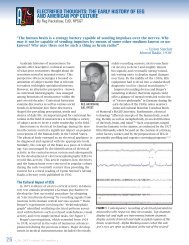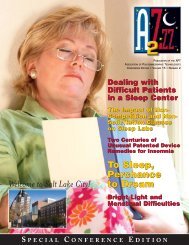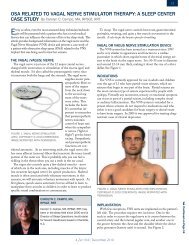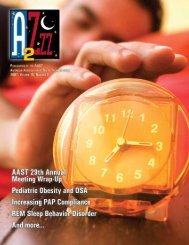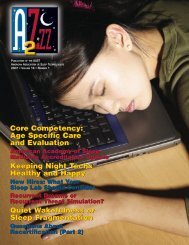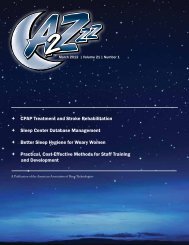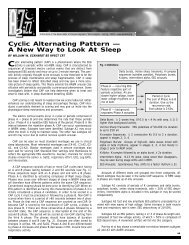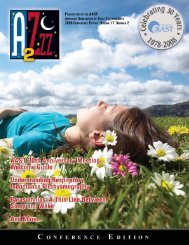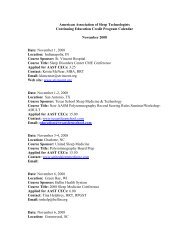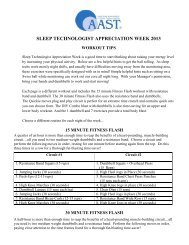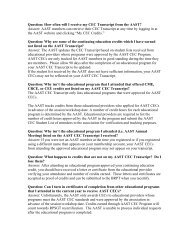APT Practice Parameter for Standard Polysomnography APT ...
APT Practice Parameter for Standard Polysomnography APT ...
APT Practice Parameter for Standard Polysomnography APT ...
- No tags were found...
Create successful ePaper yourself
Turn your PDF publications into a flip-book with our unique Google optimized e-Paper software.
<strong>APT</strong> NewZzzPublication of the Association of Polysomnographic Technologists • 2006, Volume 15, Number 4 • www.aptweb.orgencouraged to stay and sleep (with visual monitoring), even if the recordinghas been discontinued per facility policy.4.4 Infection Control4.4.1 Patient Contact ProceduresSleep technologists should exercise Universal Precautions and precautions<strong>for</strong> prevention of the spread of tuberculosis or other infectious diseasesas appropriate 19,20 . Frequent hand washing is essential <strong>for</strong> the protection ofboth patients and sleep technologists. All items that will be in contact with apatient must be cleaned and disinfected be<strong>for</strong>e use.4.4.2 Equipment DecontaminationThere must be clearly designated areas <strong>for</strong> clean and dirty equipmentand sensors.4.4.3 Non-Disposable or Reusable ItemsNon-disposable or reusable items include items such as pneumo-tachometers,electrodes, respiratory belts, thermocouples, and body position sensors.Various disinfectant products are available commercially. These products arelabeled with the instructions <strong>for</strong> disinfecting reusable items and the reusableitems should have instructions <strong>for</strong> disinfecting and cleaning recommended bythe manufacturer. When reusable items become contaminated and disinfectingis not feasible, gas or heat sterilization may be used or the item should beproperly disposed of. Bed linens should be handled with the assumption thatbiohazard could be present. Overall, it is recommended to use disinfectingproducts or procedures that are approved <strong>for</strong> the medical setting.4.4.4 Disposable ItemsThe syringe and flat-tipped needle used to inject electrolyte into the cupof electrodes should be discarded after use with the needle placed in areceptacle <strong>for</strong> needles 21 . Disposable sensors should be disposed of afteruse. Likewise, nasal cannulas used <strong>for</strong> administering oxygen or to monitorflow with a pressure transducer are <strong>for</strong> single patient use only. These typesof products should be disposed after each patient use.Footnotes1. Kushida CA, et al., <strong>Practice</strong> <strong>Parameter</strong>s <strong>for</strong> the Indications <strong>for</strong><strong>Polysomnography</strong> and Related Procedures: An Update <strong>for</strong> 2005 Sleep2005;28:499-529.2. Association of Polysomnographic Technologists, eds. Job Descriptions.Westchester, IL. Available at: http://aptweb.org/pdf/JobDescriptions.pdf3. American Academy of Sleep Medicine, eds. International Classification ofSLEEP DISORDERS, 2nd ed, Diagnostic and Coding Manual. Westchester,Illinois, 2005.4. Chokroverty S. Polysomnographic technique: an overview. In: SleepDisorders Medicine 2nd ed. Boston: Butterworth Heinemann; 1999:158. ; Butkov N. Atlas of Clinical <strong>Polysomnography</strong>, vol.1. Ashland, OR:Synapse Media, 1996: 11. Lee-Chiong T, Sateia M, Carskadon M, eds.Sleep Medicine. Hanley & Belfus, 2002: 615.5. Tyner F, Knott J, Mayer W Jr. Fundamentals of EEG Technology Volume1: Basic Concepts and Methods. New York: Raven Press;1983: 126.6. Lee-Chiong T, Sateia M, Carskadon M, eds. Sleep Medicine. Hanley &Belfus, 2002: 647.7. Jasper H.H. The ten twenty system of the International Federation.Electrencephalogr Clin Neurophysiol, 1958; 10:371-375.9. Butkov N. Atlas of Clinical <strong>Polysomnography</strong>, vol.1. Ashland, OR: SynapseMedia, 1996: 6.10. Forouzan BA, Fegan SC. Data Communications and Networking 2nd ed.Boston: McGraw-Hill, 2001:105.10. Chokroverty S. Polysomnographic technique: an overview. In: SleepDisorders Medicine 2nd ed. Boston: Butterworth Heinemann; 1999: 159.11. American Academy of Sleep Medicine, eds. <strong>Standard</strong> 17: Charting. In:<strong>Standard</strong>s <strong>for</strong> Accreditation of a Sleep Disorders Center. Westchester,Illinois: 2006.12. Redline S, Kirchner HL, Quan SF, et al. The effects of age, sex, ethnicity,and sleep-disordered breathing on sleep architecture. Arch InternMed 2004; 164:406-418.13. Somers VK, Javaheri S. Cardiavascular effects of sleep-related breathingdisorders. In: Kryger MH, Roth T, Dement WC, eds. Principles and<strong>Practice</strong>s of Sleep Medicine, 4th ed. Philadelphia: Elsevier Saunders;2005: 1182-1186.14. Association of Polysomnographic Technologists, eds. Job Descriptions.Westchester, IL. Available at: http://aptweb.org/pdf/JobDescriptions.pdf15. American Academy of Sleep Medicine, eds. <strong>Standard</strong> 3: Personnel.<strong>Standard</strong>s <strong>for</strong> Accreditation of a Sleep Disorders Center. Westchester,IL: 2006.16. Health Insurance Portability and Accountability Act of 1996 Available at:http://www.cms.hhs.gov/HIPAAGenInfo.17. American Academy of Sleep Medicine, eds. <strong>Standard</strong> 8: Facility andEquipment. <strong>Standard</strong>s <strong>for</strong> Accreditation of a Sleep Disorders Center.Westchester, Illinois: 2006.18. Occupational Safety & Health Administration, Occupational Safety andHealth <strong>Standard</strong>s: Exit Routes, Emergency Action Plans, and FirePrevention Plans — 1910 Subpart E App. Available at:http://www.osha.gov/pls/oshaweb.19. Centers <strong>for</strong> Disease Control. Guidelines <strong>for</strong> preventing the transmissionof tuberculosis in health-care settings, with special focus on HIV-relatedtissues. MMWR 1990; 39 (RR-17): 1-29.20. Centers <strong>for</strong> Disease Control. Update: Universal Precautions <strong>for</strong> preventionof transmission of human immunodeficiency virus, hepatitis B virus,and other bloodborne pathogens in healthcare settings. MMWR 1988;37: 377-382, 387-388.21. Occupational Safety & Health Administration, Occupational Safety andHealth <strong>Standard</strong>s: Bloodborne pathogens — 1910.1030. Available at:http://www.osha.gov/pls/oshaweb.<strong>APT</strong> Continuing EducationCredit Program —NEW Applications areNow AvailableTo meet the growing professional and educational needs of theSleep Technology Profession, the Association of PolysomnographicTechnologists (<strong>APT</strong>) has revised and expanded the ContinuingEducation Credit (CEC) Program. Educational Providers now havethe opportunity to apply <strong>for</strong> <strong>APT</strong> CECs through four educationalcategories:1. In-Service/Case Conference — (one to two hour program)2. Single Lecture/Workshop — (one to two hour program)3. Educational Programs, Training Course, Seminar, etc. —(more than two hour program)4. Computer Based Learning Activities (i.e. CD-ROM’s,DVD’s, Webinars, and Internet)For additional in<strong>for</strong>mation on the new <strong>APT</strong> CEC applications,visit the <strong>APT</strong> Web site at www.<strong>APT</strong>Web.org.13



